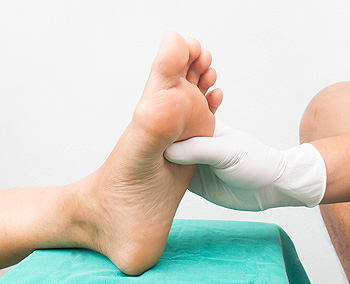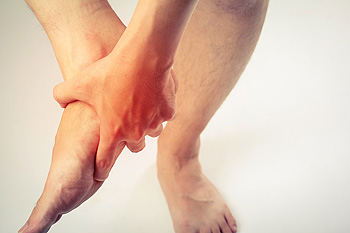Items filtered by date: December 2024
Essential Foot Care Tips for Diabetic Patients

Foot care is critical for individuals with diabetes, as high blood sugar levels can lead to nerve damage and poor circulation, increasing the risk of foot problems. Regular inspection of the feet is important to detect any cuts, blisters, or infections early. It is recommended to wash the feet daily with warm water and mild soap, ensuring they are thoroughly dried, especially between the toes. Moisturizing the feet can prevent dry skin, but individuals should avoid applying lotion between the toes to prevent fungal infections. Wearing proper footwear is essential to protect the feet from injury. Shoes should be well-fitted and cushioned to avoid pressure points. It is also important to trim toenails carefully to avoid ingrown nails. If you have diabetes, it is strongly suggested that you are under the care of a podiatrist who can help manage foot health and prevent complications associated with diabetes.
Diabetic foot care is important in preventing foot ailments such as ulcers. If you are suffering from diabetes or have any other concerns about your feet, contact Jack A. Sasiene, DPM from Texas. Our doctor can provide the care you need to keep you pain-free and on your feet.
Diabetic Foot Care
Diabetes affects millions of people every year. The condition can damage blood vessels in many parts of the body, especially the feet. Because of this, taking care of your feet is essential if you have diabetes, and having a podiatrist help monitor your foot health is highly recommended.
The Importance of Caring for Your Feet
- Routinely inspect your feet for bruises or sores.
- Wear socks that fit your feet comfortably.
- Wear comfortable shoes that provide adequate support.
Patients with diabetes should have their doctor monitor their blood levels, as blood sugar levels play such a huge role in diabetic care. Monitoring these levels on a regular basis is highly advised.
It is always best to inform your healthcare professional of any concerns you may have regarding your feet, especially for diabetic patients. Early treatment and routine foot examinations are keys to maintaining proper health, especially because severe complications can arise if proper treatment is not applied.
If you have any questions please feel free to contact our offices located in Texas City and Lake Jackson, TX . We offer the newest diagnostic and treatment technologies for all your foot and ankle needs.
Foot and Ankle Pains Associated With Pickleball

Pickleball is soaring in popularity as a low-impact, fast-paced sport enjoyed by players of all ages. However, its quick pivots and sudden stops can still lead to foot and ankle injuries. Acute injuries, such as ankle sprains, often occur when the foot rolls inward, called inversion, causing pain and swelling. Falls during gameplay can also lead to fractures or bruising, especially for beginners or those returning to exercise. Overuse injuries like Achilles tendon strain are common, especially in players who increase intensity too quickly without proper warm-ups. These injuries can result in stiffness, swelling, or even tears if untreated. Wearing supportive shoes, strengthening muscles, and maintaining flexibility are key to preventing injuries. If you have injured your foot or ankle while playing pickleball and pain or swelling persists, it is suggested that you visit a podiatrist for an expert diagnosis and tailored treatment, ensuring you get back on the court as soon as possible without compromising your mobility.
Sports related foot and ankle injuries require proper treatment before players can go back to their regular routines. For more information, contact Jack A. Sasiene, DPM of Texas. Our doctor can provide the care you need to keep you pain-free and on your feet.
Sports Related Foot and Ankle Injuries
Foot and ankle injuries are a common occurrence when it comes to athletes of any sport. While many athletes dismiss the initial aches and pains, the truth is that ignoring potential foot and ankle injuries can lead to serious problems. As athletes continue to place pressure and strain the area further, a mild injury can turn into something as serious as a rupture and may lead to a permanent disability. There are many factors that contribute to sports related foot and ankle injuries, which include failure to warm up properly, not providing support or wearing bad footwear. Common injuries and conditions athletes face, including:
- Plantar Fasciitis
- Plantar Fasciosis
- Achilles Tendinitis
- Achilles Tendon Rupture
- Ankle Sprains
Sports related injuries are commonly treated using the RICE method. This includes rest, applying ice to the injured area, compression and elevating the ankle. More serious sprains and injuries may require surgery, which could include arthroscopic and reconstructive surgery. Rehabilitation and therapy may also be required in order to get any recovering athlete to become fully functional again. Any unusual aches and pains an athlete sustains must be evaluated by a licensed, reputable medical professional.
If you have any questions please feel free to contact our offices located in Texas City and Lake Jackson, TX . We offer the newest diagnostic and treatment technologies for all your foot and ankle needs.
What Causes an Ingrown Toenail to Become Infected?

An ingrown toenail occurs when the edge of the toenail grows into the surrounding skin causing pain, redness, and swelling. This condition typically affects the big toe, although it can occur on any toe. Ingrown toenails are often caused by improper nail trimming, where nails are cut too short or rounded at the corners. Wearing tight-fitting shoes that apply pressure on the toes can also contribute to the problem. In some cases, trauma or injury to the toenail can lead to an ingrown toenail. The nails can become infected when left untreated, leading to increased pain, pus, and inflammation. Infection occurs when bacteria enter the broken skin surrounding the nail, causing the area to become swollen and tender. If you have an ingrown toenail, it is suggested that you consult a podiatrist who can offer effective treatment options that may keep it from getting infected.
Ingrown toenails may initially present themselves as a minor discomfort, but they may progress into an infection in the skin without proper treatment. For more information about ingrown toenails, contact Jack A. Sasiene, DPM of Texas. Our doctor can provide the care you need to keep you pain-free and on your feet.
Ingrown Toenails
Ingrown toenails are caused when the corner or side of a toenail grows into the soft flesh surrounding it. They often result in redness, swelling, pain, and in some cases, infection. This condition typically affects the big toe and may recur if it is not treated properly.
Causes
- Improper toenail trimming
- Genetics
- Improper shoe fitting
- Injury from pedicures or nail picking
- Abnormal gait
- Poor hygiene
You are more likely to develop an ingrown toenail if you are obese, have diabetes, arthritis, or have any fungal infection in your nails. Additionally, people who have foot or toe deformities are at a higher risk of developing an ingrown toenail.
Symptoms
Some symptoms of ingrown toenails are redness, swelling, and pain. In rare cases, there may be a yellowish drainage coming from the nail.
Treatment
Ignoring an ingrown toenail can have serious complications. Infections of the nail border can progress to a deeper soft-tissue infection, which can then turn into a bone infection. You should always speak with your podiatrist if you suspect you have an ingrown toenail, especially if you have diabetes or poor circulation.
If you have any questions, please feel free to contact our offices located in Texas City and Lake Jackson, TX . We offer the newest diagnostic and treatment technologies for all your foot care needs.
How Cuboid Syndrome Is Diagnosed

Cuboid syndrome is a condition that affects the foot, specifically the cuboid bone, which is one of the seven tarsal bones located on the outer side of the foot. This syndrome occurs when the cuboid bone becomes slightly misaligned or stiff, often leading to pain in the outer part of the foot. The main causes of cuboid syndrome include sudden movements, foot injuries, overuse, or wearing improper footwear. Activities such as running, jumping, or twisting can strain the cuboid bone and surrounding tissues. Common symptoms include localized pain, swelling, and tenderness on the outer foot, in addition to difficulty walking or bearing weight. To diagnose cuboid syndrome, a podiatrist typically conducts a physical examination and may perform specific manipulation tests. In some cases, imaging tests like X-rays or MRI scans may be used to rule out other conditions and confirm the diagnosis. If you have pain in the outer part of your foot, it is suggested that you consult a podiatrist who can accurately diagnose and treat the problem.
Cuboid syndrome, also known as cuboid subluxation, occurs when the joints and ligaments near the cuboid bone in the foot become torn. If you have cuboid syndrome, consult with Jack A. Sasiene, DPM from Texas. Our doctor will assess your condition and provide you with quality foot and ankle treatment.
Cuboid syndrome is a common cause of lateral foot pain, which is pain on the outside of the foot. The condition may happen suddenly due to an ankle sprain, or it may develop slowly overtime from repetitive tension through the bone and surrounding structures.
Causes
The most common causes of cuboid syndrome include:
- Injury – The most common cause of this ailment is an ankle sprain.
- Repetitive Strain – Tension placed through the peroneus longus muscle from repetitive activities such as jumping and running may cause excessive traction on the bone causing it to sublux.
- Altered Foot Biomechanics – Most people suffering from cuboid subluxation have flat feet.
Symptoms
A common symptom of cuboid syndrome is pain along the outside of the foot which can be felt in the ankle and toes. This pain may create walking difficulties and may cause those with the condition to walk with a limp.
Diagnosis
Diagnosis of cuboid syndrome is often difficult, and it is often misdiagnosed. X-rays, MRIs and CT scans often fail to properly show the cuboid subluxation. Although there isn’t a specific test used to diagnose cuboid syndrome, your podiatrist will usually check if pain is felt while pressing firmly on the cuboid bone of your foot.
Treatment
Just as the range of causes varies widely, so do treatments. Some more common treatments are ice therapy, rest, exercise, taping, and orthotics.
If you have any questions, please feel free to contact our offices located in Texas City and Lake Jackson, TX . We offer the newest diagnostic and treatment technologies for all your foot care needs.
Common Causes of Heel Pain

Heel pain is a complex issue that can disrupt daily activities and exercise routines. Three prevalent causes include plantar fasciitis, bone spurs, and Sever’s disease. Plantar fasciitis involves inflammation of the plantar fascia, a thick band of tissue running along the bottom of the foot, typically causing pain near the heel. Bone spurs are bony growths that develop on the heel, often resulting from prolonged stress on the foot and sometimes causing sharp pain. Sever's disease, most common in children and adolescents, is an inflammation of the growth plate in the heel, resulting from repetitive stress during periods of rapid growth. If you suffer from persistent heel pain, it is suggested that you visit a podiatrist who can properly diagnose heel pain and create a tailored treatment plan, which may include targeted exercises and orthotic support to alleviate pain and support healing.
Many people suffer from bouts of heel pain. For more information, contact Jack A. Sasiene, DPM of Texas. Our doctor can provide the care you need to keep you pain-free and on your feet.
Causes of Heel Pain
Heel pain is often associated with plantar fasciitis. The plantar fascia is a band of tissues that extends along the bottom of the foot. A rip or tear in this ligament can cause inflammation of the tissue.
Achilles tendonitis is another cause of heel pain. Inflammation of the Achilles tendon will cause pain from fractures and muscle tearing. Lack of flexibility is also another symptom.
Heel spurs are another cause of pain. When the tissues of the plantar fascia undergo a great deal of stress, it can lead to ligament separation from the heel bone, causing heel spurs.
Why Might Heel Pain Occur?
- Wearing ill-fitting shoes
- Wearing non-supportive shoes
- Weight change
- Excessive running
Treatments
Heel pain should be treated as soon as possible for immediate results. Keeping your feet in a stress-free environment will help. If you suffer from Achilles tendonitis or plantar fasciitis, applying ice will reduce the swelling. Stretching before an exercise like running will help the muscles. Using all these tips will help make heel pain a condition of the past.
If you have any questions please contact our offices located in Texas City and Lake Jackson, TX . We offer the newest diagnostic and treatment technologies for all your foot and ankle needs.

